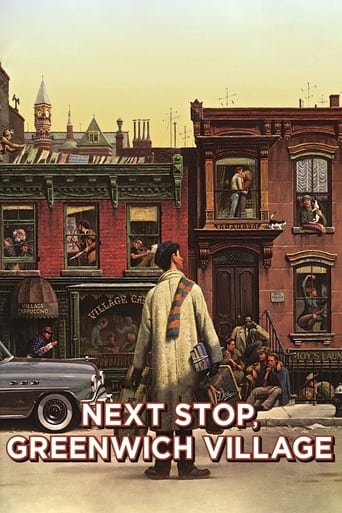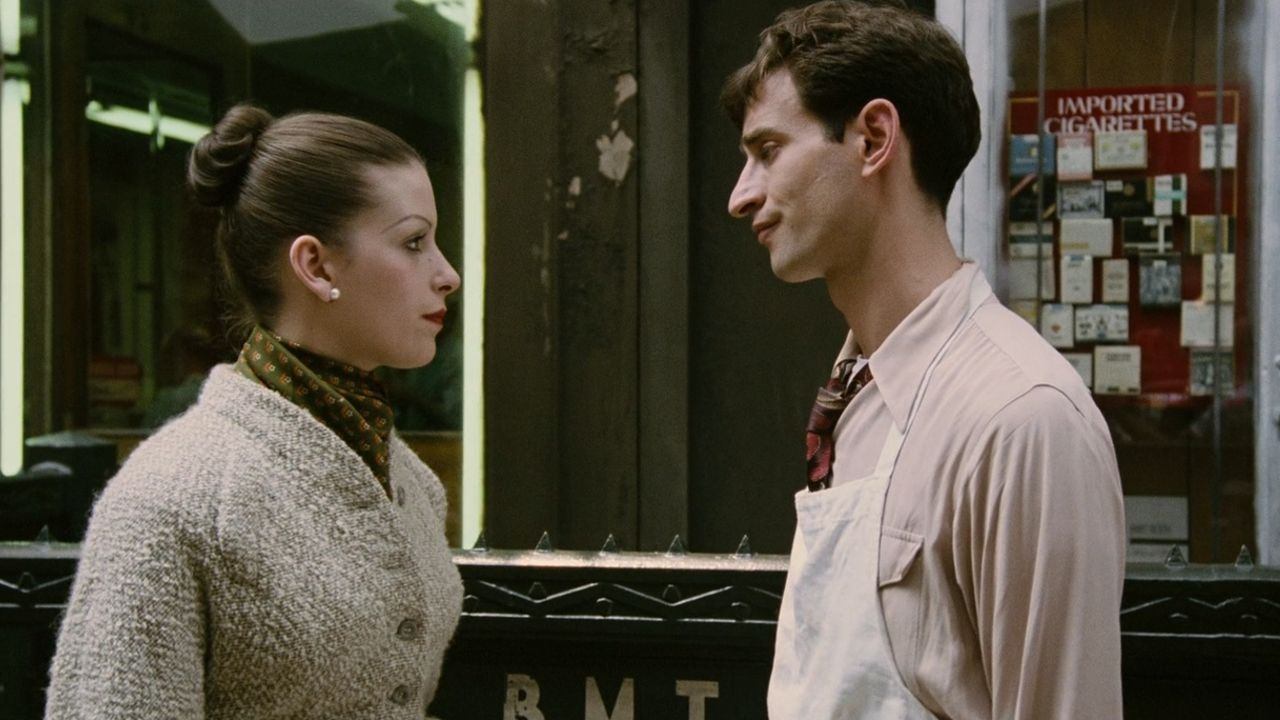blanche-2
Admittedly I come to this film with a deep prejudice. Though it's set in 1953, it was released in 1976, the same year I moved to Greenwich Village. In fact, much of the movie looks to have been filmed about two blocks west of where I lived for 30 years.For a young person moving to Greenwich Village, there's something timeless about the experience, as this film shows. Directed by Paul Mazursky, the film stars Lenny Baker, Shelley Winters, Ellen Greene, Christopher Walken, Lois Smith, and Dori Brenner. Baker is an aspiring young actor named Larry Lapinsky, who leaves his parents' apartment and his sobbing mother (Winters) to take a place in the Village. There, he gets a day job, a girlfriend (Greene), a group of bizarre friends, and starts acting class. He uses a liquor bottle he finds at the subway as an Oscar and thanks the Academy while he waits for a train; he does impressions of Brando for a cop; he does a scene from Golden Boy for class. Mazursky has left nothing out, not the overblown egomaniacal young actor (Jeff Goldblum) whom Larry meets at an audition, the bipolar young woman (Smith), the gay friend (Antonio Fargas), the poser who's a chick magnet (Walken), and everybody's friend destined to be unlucky in love (Brenner). It's a madcap, free, painful, and sobering existence.Baker is wonderful as Larry, anxious to get out and live. He's very likable. Shelley Winters is a riot as the Jussi Bjorling-loving Faye Lapinsky, who keeps dropping in and bringing food while she and her husband are in the neighborhood. At one point, she is so convincing telling Sarah (Greene) that she doesn't care if Sarah has been having sex with Larry, that Sarah admits to it, thus driving Faye into such a state that Sarah claims she lied. Lois Smith is very effective as the neurotic Anita. Dori Brenner does a great job as the caring friend, and Christopher Walken strikes the right balance as the enigmatic, distant Robert.Highly recommended, and if you've ever lived in Greenwich Village, or tried to be an actor in New York, don't miss it.What makes the film is the New York energy and the locations - many of which still exist, Village Cigars, Smiler's, the lamp store, Julius' bar, the whole Christopher Street area.
steve_jacobs
I felt like this is what life must truly have been like in the Village in '53. Everything was in order. I was transported. Special kudos go out to Antonio Fargas, who plays a gay man in a tremendously ballsy portrayal considering his Starsky and Hutch days. Also, to the great chemistry of the cast.It was sad to see Lenny Baker passed away at such a young age. He was definitely in the Hoffman, Pacino, but funnier mold. He should be remembered.
Blooeyz2001
This is a bittersweet film about family, leaving "the nest", friendships, dreams, hope, & finding yourself. A young man from Brooklyn leaves home to become an actor in 1950's Greenwich Village. Lenny Baker is very good as Larry Lapinsky & Ellen Green is wonderful as his girlfriend. The quirky characters & situations around them add an ambiance to this movie that makes you believe it was filmed in the 1950's, & not the 70's, when it was actually made. A lot of attention was paid to detail & it shows. Shelly Winters is loud, obnoxious, funny & convincing as the typical Jewish mother (I love the scene when she shows up at his apartment with a chicken). This movie makes you wish you could jump into the film & sit with these characters, have coffee with them, ride the subway, go to one of Larry's rent parties & experience the progressive, offbeat world of New York's Greenwich Village in the 1950's.
Allen J. Duffis (sataft-2)
During June of 1954 in New York City, I graduated junior high school and, to celebrate the event, joined three of my classmates on a forbidden sojourn to the city's famous Greenwich Village. Exiting the subway station at Christopher street, we were amazed at the apparent ordinariness of this place we'd heard so much about from older adolescents and adults.
In fact, at first glance, nothing extraordinary seemed to be happening there, with the sole exception of more White people being present than four Black teenagers from Harlem were were accustomed to seeing.
For you see, this was the mid 1950's, Dr. Martin Luthor King Jr. had as yet to lead any freedom marches, Southern schools were as yet to be integrated, and in many Southern states Black people were lynched on Saturday nights as town entertainment. But three hours later, we knew that everything we'd heard about Greenwich Village was true and more. For this was a place far ahead of it's time.In the Greenwich Village of the 1950's, racial integration had been in place for well over two decades. But far more important, forbidden talk of sexual liberation, interracial sex, homosexuality, along with political, artistic and literary freedom at all levels were openly discussed, flouted and displayed for all to see; performed to a background mixture of new age Jazz, early Rock and Roll and Folk Music. Virtually nothing was excluded from the social or musical menu this incredible place had to offer.
I can't speak for the rest of my friends on that day, but I immediately fell in love with the place and remained so, until it's untimely demise at the hands of the high rise-high priced real estate industry toward the mid 1970's. By then, the people who had made the place justifiably famous and notorious for what it was, could no longer afford to live there. So the Village remained,in name only, as it is today: a mere shadow of what it used to be.Joyfully, director Paul Mazursky has managed to capture on film, a moving snapshot of the social life and time of a remarkable neighborhood, in what was probably the last fifteen to twenty years of it's legitimate life. And I do remember it so well. The rent parties for starving (sometimes talented) artists, the ubiquitous book shops, the coffee houses featuring impromptu poetry readings, the fashion statements (or blatant lack thereof), the mixing and making of all sorts of colorful characters who, even in their farcical attempts to parody themselves, were more alive and real then those who would put them down. This was the Greenwich Village of the 1950's and of legend.This magical place was for me and many others (as was for the director who produced this film as an ode to his time there), our first real awakening and taste of adult life. And far more important, a fortuitous preparation for the new social order that was, in time, to come.The place, as it was, is truly deserving of this wonderful little gem of a film.


 AD
AD



